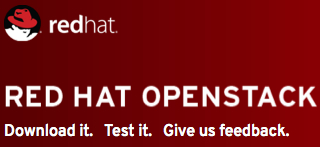Red Hat on Monday announced its intention to provide an enterprise-grade version of the popular open source cloud framework, OpenStack. The company behind the enterprise operating system Red Hat Enterprise Linux rolled out the preview release of its OpenStack distribution, which allows companies or service providers to create Infrastructure-as-a-Service (IaaS) clouds.
 The large community of OpenStack supporters, including Red Hat, which joined the project in April, is pinning its hopes to the open source cloud “operating system” as an alternative to proprietary Infrastructure-as-a-Service offerings, namely VMware on the private cloud side and Amazon and Microsoft on the public cloud side.
The large community of OpenStack supporters, including Red Hat, which joined the project in April, is pinning its hopes to the open source cloud “operating system” as an alternative to proprietary Infrastructure-as-a-Service offerings, namely VMware on the private cloud side and Amazon and Microsoft on the public cloud side.
Red Hat says that its planned enterprise-ready distribution of OpenStack will complement its portfolio of open source products, which according to a company FAQ includes “Red Hat Enterprise Virtualization for managing virtualized datacenters, Red Hat Enterprise Linux and JBoss Middleware for building cloud applications, Red Hat Storage for hybrid cloud data access and storage, CloudForms for hybrid cloud management, and OpenShift for PaaS.”
In the scheme of computing, cloud is still young, and open source cloud younger still, but the field has taken off at a surprising clip. OpenStack, which just turned two and includes a community of 3,386 people and nearly 200 companies, is quickly becoming synonymous with “open source cloud.” An OpenStack Foundation is also well under way, with a noteworthy platinum member roster that includes AT&T, Canonical, Hewlett-Packard, IBM, Nebula, Red Hat, SUSE, and of course the company who co-founded the project with NASA in 2010, Rackspace. This highest tier of supporters enjoy a greater degree of control and responsibility in exchange for a $500,000 annual sponsorship.
According to a recent survey, Red Hat ranked third in total code submitted, behind lead contributor Rackspace and second runner-up Nebula. If you were guessing HP was fourth, you’d be correct. Red Hat competitor Canonical is fifth, followed by ex-BFF Citrix, which dumped OpenStack to back competing open source project CloudStack. Picked up by Citrix as part of the cloud.com acquisition, CloudStack was donated to the Apache Software Foundation in April. It claims around 50 supporting members and 100-some deployments, including notable users NTT, Tata, Softlayer and GreenQloud.
Internap, HP and Rackspace were first to the table with OpenStack implementations and there’s a lot riding on these projects. Every one of the 186 participating companies has a vested interest in the success of OpenStack; none more than Rackspace itself, which officially migrated to the OpenStack codebase on Aug. 1.
While the Webosphere was still lit up over the Rackspace OpenStack migration, an InfoWorld article revealed a major e-retailer customer win for OpenStack. Web auction innovator eBay announced it is leveraging OpenStack to manage “a high-volume dev, test, and experimentation environment where apps are created for eBay Marketplaces.” Cloud Architect for eBay Jean-Christophe Martin noted that the initial project was small but suggested it will expand as OpenStack continues to add functionality. Although eBay is using OpenStack to tunnel out of VMware’s walled garden, it is also relying on Nicira – recently bought by VMware for $1.26 billion – for network virtualization. The technology, which forms the basis of OpenStack’s “Quantum” networking component, allows eBay to spin up “hundreds of projects” on a per app basis.
The OpenStack software includes compute, storage and networking components, but it is more a collection of services than a unified product. For enterprises that lacked in-house coding expertise or would-be cloud users who just “wanted things to work,” a proprietary product like VMware (private) or Amazon (public) was the only option until recently. Now Red Hat joins the growing ranks of enterprise OpenStack companies, like Piston Computing and Nebula, who are providing supported solutions around this “do-it-yourself” software stack. Supported open source products offer users additional service and reliability guarantees, while maintaining the benefits of open source, most obviously portability and freedom from vendor lock-in, but also additional flexibility and increased customization.
As for what sets Red Hat’s OpenStack version apart from other supported versions, the company says that “Red Hat has the unique advantage of already having taken several major open source projects (Linux, JBoss, Gluster, etc) and turning them into successful enterprise ready products. Red Hat is leveraging its proven product development and delivery processes to create a quality OpenStack product that any enterprise can use. Red Hat is also rallying its extensive OEM, ISV, and public cloud partnerships to provide the certifications, support, and ecosystem demanded by enterprise customers. It takes a unique set of skills and partnerships to create a successful product based on an open source project and only Red Hat has demonstrated time and time again that it has those qualities.”
The preview version of Red Hat OpenStack is based on the “Essex” release and works with Red Hat Enterprise Linux 6.3 or higher. The commercial version, due out sometime next year, will be updated with the upcoming OpenStack “Folsom” distribution. Although the preview version is itself free, all servers targeted for installation are required to have a Red Hat Enterprise Linux subscription. Red Hat CTO Brian Stevens invites developers and end-users to kick the tires and share their gleanings.
“Our current productization efforts are focused around hardening an integrated solution of Red Hat Enterprise Linux and OpenStack to deliver an enterprise-ready solution that enables enterprises worldwide to realize infrastructure clouds,” says Stevens. “We invite OpenStack enthusiasts and enterprises interested in the technology to download our preview and provide feedback to help us accelerate the delivery of a stable OpenStack enterprise platform for the industry.”




























































